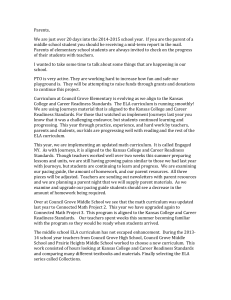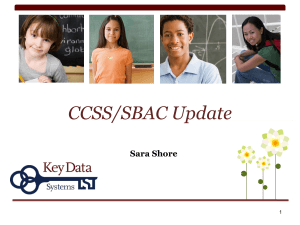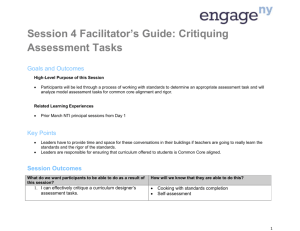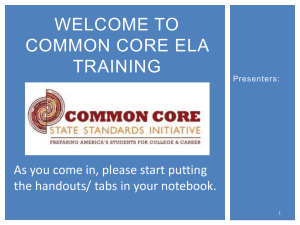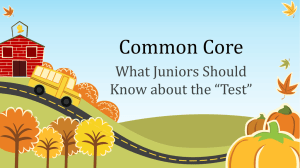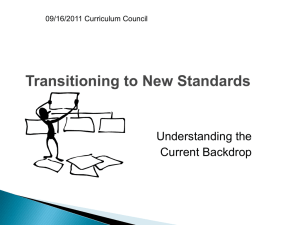ppt, 1.3mb - Public Schools of North Carolina
advertisement
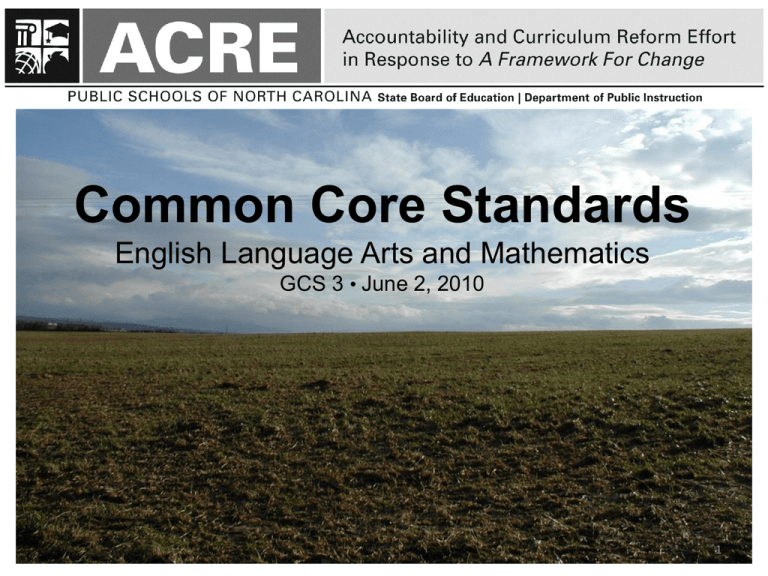
Common Core Standards English Language Arts and Mathematics GCS 3 • June 2, 2010 1 Overview of the Initiative o State-led and developed Common Core Standards for K-12 in English Language Arts and Mathematics o Focus on learning expectations for students, not how students get there 2 Similar Goals for Standards North Carolina’s Mandates “Essential” “Narrow” “Deep” “Rigorous + Relevant” “Readiness for College and Career” “Enduring” “Measurable” “Clear and Concise” Common Core “Essential” ”Fewer, Higher, Clearer” ”Focused” ”Rigorous” ”Readiness for College and Career” “Prioritized and Focused” 3 Who is a part of the Initiative? Initially, 48 states, the District of Columbia, and two territories signed on to the Common Core State Standards Initiative. 4 Rationale o Equity Students expectations the same regardless of where they live o College and Career Readiness Students need to be more than proficient o Comparability State results will be comparable through common assessments o Sharing of Resources The ability to share instructional materials across state lines can improve practice o Economies of Scale Possible savings due to sharing of resources and assessments o Student Mobility Students moving into and out of states will have the same standards 5 Development Process o College and career readiness standards developed in summer 2009 o Based on the college and career readiness standards, K-12 learning progressions developed o Multiple rounds of feedback from states, teachers, and feedback group and validation committee o Groups representing English language learners and students with disabilities were instrumental in developing the ELL and students with disabilities statements in the introduction to the standards o Public comment period on K-12 standards ended April 2. NC Input 6 Math Common Core and NC Involvement Draft 1 of Common Core Draft 2 of Common Core Draft 3 of Common Core NC Input Content alignment w/ES; grade placement differences NC Input Content alignment w/ES; stronger alignment with w/grade placement NC Input Confident in content alignment; strong grade placement alignment with ES 7 English Common Core and NC Involvement Fall 2009 Beginning Development of ELA Beginning Development of Common Core Draft 1 of Common Core Draft 2 of Common Core Draft 3 of Common Core NC Input Broad themes and gradecluster alignment; Common Core more specific, no taxonomy NC Input ES developed in tandem with the Common Core; some concerns about grade cluster placement NC Input Strong • Attended more fully to technical writing • Clarified grade-by-grade progressions • K-2 more developmentally appropriate 8 June 2, 2010 Release of Final Common Core Standards www.corestandards.org 9 ELA Standards Advances o Text complexity o Balance of literature and informational texts o Direct link to college and work readiness o Literacy standards for science and social studies o Clear vertical progressions across grades 10 ELA Standards: Writing Sample Research to Build and Present Knowledge Kindergarten Participate in shared research and writing projects (e.g., explore a number of books by a favorite author and express opinions about them). 1st Participate in shared research and writing projects (e.g., explore a number of “how-to” books on a given topic and use them to write a sequence of instructions). 2nd Participate in shared research and writing projects (e.g., read a number of books on a single topic to produce a report; record science observations). 11 Math Standards Advances o Focus in early grades on number (arithmetic and operations) to build a solid foundation in math o Evened out pace across the grades o High school math focus on using math and solving messy problems, similar to what would see in the real world o Problem-solving and communication emphasized 12 Math Standards 2nd Grade Number and Operation Common Core Understanding Place Value # 4: Compare two three-digit numbers based on meanings of the hundreds, tens, and ones digit, using ‹, =, and › symbols to record the results of comparisons. 2009 Essential Standards 2.N.1.5 Compare whole numbers less than 1,000 with symbols (<, >) and words. 2003 Standard Course of Study 1.01 Develop number sense for whole numbers through 999. c) Compare and order. 13 Plan to Support and Transition For All New Standards for Teachers and Leaders Tools & Professional Development Online Modules, Webinars, Forums for Teachers and Leaders Face-to-Face Including partnering with other PD organizations 14 Plan to Support and Transition For All New Standards Tools Instructional Toolkits including: o Crosswalks between Old and New o Vertical Learning Progressions o Glossary of Terms o Unpacked Content o Assessment Prototypes o Lesson Plans, Unit Plans o Diagnostic, Formative, and Benchmarking Assessment Tools 15 Plan to Support and Transition For All New Standards Professional Development Provide PD so that educators can: o Use valid, reliable assessments and data to diagnose need, inform instruction, and monitor progress o Identify the prerequisite knowledge and skills that are key to mastery of a standard o Connect and apply standards across subject areas o Create plans – long-term, unit, and daily – that lead students to mastery of the standards o Explain a standard in student-friendly language and make simple and compelling arguments to students as to why the standard matters o Know and plan for common student mistakes or likely misunderstandings 16 Plan to Support and Transition Specific to the Common Core Standards in ELA and Math o Leveraging Shared Standards Connecting educators to shared resources that will develop nationally around ELA and Math o Building an Understanding of the Common Core Unpacking the Common Core so educators know specifically what a student will know and be able to do o Connecting the Common Core to the Revised Bloom’s Taxonomy Interpreting the Common Core through the lens of the taxonomy to provide uniformity in all content areas o Common Core Format Implications Providing support around understanding the way the Common Core is organized (which is different than the ES) and what that means for instruction and assessment o Communication Plan Create communication plan to build stakeholder belief in the value of the Common Core 17 Adoption Process o State adopts 100% of the Common Core K-12 Standards in ELA and mathematics (word for word), with option of adding up to an additional 15% of standards on top of the core o A state will have adopted when the standards authorizing body within the state has taken formal action to adopt and implement the common core o States are responsible for demonstrating that they have adhered to this definition of adoption 18 Current Thinking about 15% In the initial review of the final standards… Math o Elementary considering adding additional statistics standards; Middle and High School comfortable with standards and grade-level placement. ELA o Content and grade-level placement are good; strong in foundational reading skills, writing, and language development. Currently, we believe we will recommend adding very little, if any, additional content. Final recommendations in July 19 What’s Next? o Determine 15% using Essential Standards Work by July 1 o Receive Public Comment through June 30 o Common Core to SBE for Adoption in June or July o Send Addendum to Race to the Top Application Evidence of adoption by August 2 is required to earn full points on section B1 (adopting shared standards) o Begin Roll-Out Plan Common Core and Essential Standards preparation with an operational date of the fall of 2012 o Partner with Hunt Institute and CCSSO for Communication Planning 20



